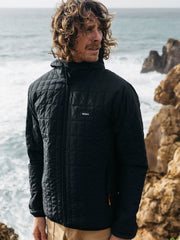The inspiration behind our RNLI Polperro jumper, we dive into the rich history of the iconic Cornish Gansey. Originally knitted by fishermen’s wives and daughters, we look at their unique construction, the meaning behind their patterns and how each could identify a sailor’s home port.
Story Of The Polperro Jumper
23.09.24
3 min read
Written by Zak Rayment
Photography by Abbi Hughes
19th Century Images from Cornish Guernseys & Knit-frocks, with special thanks to the Polperro Heritage Press.
A Cornish Gansey, sometimes referred to as a Guernsey, was a tightly-knitted woollen sweater designed to keep out wind and salt spray, protecting the fishermen going bravely out to sea in the treacherous waters surrounding the British Isles. Popular in the late 1800s, Ganseys can be traced to many areas around the UK coastline but in Cornwall the style took on a cultural and familial significance. Handed down from mother to daughter, the unique designs and patterns would be specific to the Cornish fishing village where the jumper was made.
From the Lizard to Looe, Sennen to the Isles of Scilly, these distinctive local designs were recorded by Mary Wright in the 1970s. A knitting enthusiast who was commissioned to recreate a traditional Gansey jumper for the Royal Cornwall Show, Mary became something of an amateur historian as she pored through old photographs of fishermen to find the information needed to revive this traditional 200-year-old craft. The book resulting from this research, Cornish Guernseys and Knit-frocks, contained 30 designs painstakingly interpreted from old photographs.
An unnamed fisherman wearing an intricately patterned gansey.
Charles Jolliff Sr, his son Charles Jr and Jim Curtis holding his daughter Kate, in Polperro in the late 1870s.
Hand-knitted “in the round” (as one whole garment, without seams that might let the weather in) these jumpers harnessed the natural insulating properties and water-repellency of wool and were commonly made of a highly twisted five-ply yarn known as “seaman’s iron” for its durability and ability to protect the wearer. This particular knitting technique required a great deal of skill, and jumpers would be knitted both for family and on commission. Cornish girls would learn from a very young age so that they could contribute to the family’s income, and the ganseys were often knitted in procession. The youngest would knit the rib, older girls would knit the body and the mother would take on the more arduous task of knitting the pattern.
They were a true working fisherman’s garment – comfortable, warm and durable, with special arm gussets for free movement when hauling in the day’s catch, and a weave so tight it was practically waterproof. However they also took on meaning within the community, and ganseys with more intricate designs would sometimes be knitted to be worn as Sunday “best” at church. In fact, one design recorded during Mary Wright’s research was that of the Vicar of Morwenstow, a Reverend Robert Stephen Hawker, who would always wear a fisherman’s gansey to symbolise that he was a “fisher of men”, a reference to his role as a pastor in guiding his community.
Jane Jilloff knits while awaiting her husband's return, overlooking Peak Rock on the cliffs above Polperro.
Behind the romance and nostalgia though, there are tales that these unique identifying patterns had a more sombre use. Before the creation of the RNLI in 1824, fishermen of the day faced the very real prospect of losing their lives when they ventured out to sea. Some have theorised that with designs unique to each Cornish village and fishing port, should tragedy strike, a drowned sailor could be identified and their body returned to their family.
An homage to those intrepid early seafarers, our own Polperro Jumper has been made in collaboration with the RNLI. A volunteer service with a proud 200 year history, 10% of the sales from the collection will go towards helping continue their vital work of saving lives at sea.

















































































